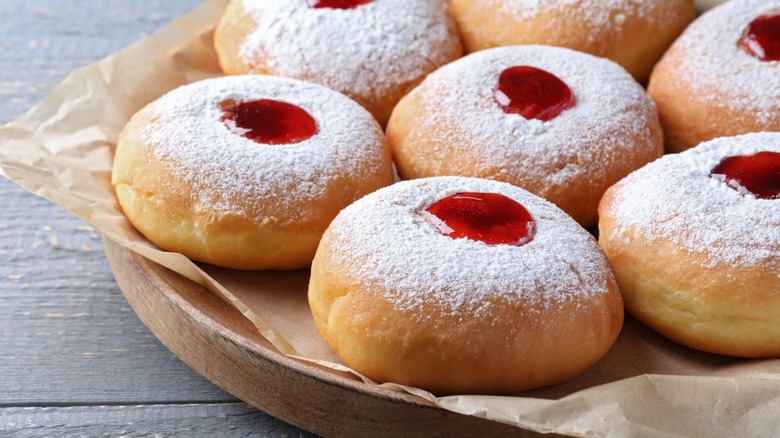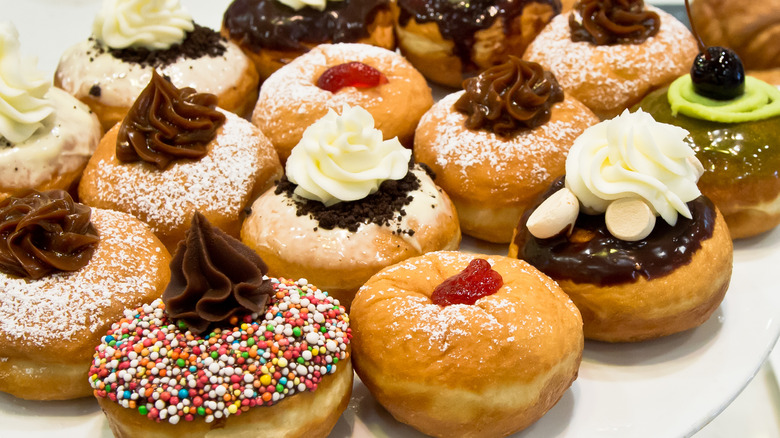What Sufganiyot Symbolize On Hanukkah
Hanukkah, also known as the Festival of Lights, commemorates the victory of a small Jewish army over a much stronger force of Syrian Greeks who had occupied the Holy Land and had attempted to suppress the Jewish religion. After the battle, as the Holy Temple in Jerusalem was rededicated (hence the name "Hanukkah," or "dedication"), a one-day supply of oil miraculously kept the temple's menorah lit for eight days. Every holiday has its food traditions, and Hanukkah is no exception. While latkes may be the most famous of this holiday's foods, jelly donuts that go by the Hebrew name of sufganiyot in Hebrew are also on the traditional Hanukkah menu. The fact that both of these are fried foods is no coincidence as they're meant to represent the miraculous olive oil that lasted for eight days.
Sufganiyot's role in the Hanukkah tradition is both ancient and modern. A 12th-century rabbi promoted the idea of eating "sufganin" on Hanukkah, although the medieval version was most likely a syrup-coated pancake. The first mention of jelly donuts didn't appear in the historical record until a 15th-century German cookbook, while donuts remained a rarity until slave-produced sugar from the Caribbean became more common in Europe. By the 16th century, however, Poles had embraced jelly donuts (known there as paczki), with Christians incorporating the treat into their Christmas celebration and Jews adopting it as a fried food of choice for Hanukkah.
Sufganiyot are super-popular in Israel
These days, sufganiyot are mostly associated with Hanukkah celebrations in Israel. Israel embraced these jelly donuts at the prodding of labor unions in the 1920s as these organizations understood that potato pancakes (latkes) were easy to make at home. Sufganiyot, on the other hand, would require professional and unionized workers to produce, market, and transport. Today, 80% of Israelis consume at least one jelly donut over the eight-day holiday.
To keep up with demand in Israel, sufganiyot are often produced on assembly lines, with the nation's largest bakery chain being said to crank out some 25,000 sufganiyot a day during the holiday season. Strawberry jam and caramel are the traditional flavors, but recent options have expanded to include cappuccino, Bavarian cream, cheesecake, and even booze-infused sufganiyot. While sufganiyot are normally made to be nearly one-quarter pound in size, some Israeli bakeries have also started making half-sized and bite-sized versions of these deep-fried, sugary pastries to appeal to those with smaller appetites.
But they're catching on in the U.S., as well
The Jewish diaspora may be a widespread one, but two countries have the Lion of Juhah's share: Israel and the United States. While Jews make up less than 3% of the nation's population, major urban centers including New York, Chicago, and Los Angeles all have a sufficiently large Jewish population that you can easily find fresh-baked (or fried) sufganiyot for Hanukkah. New York City, which has the world's largest Jewish population outside Tel Aviv, may well be sufganiyot central in November and December. New York being New York, of course, these donuts come in trendy flavors like coconut lime, yuzu basil, and even chicken liver, but you'll still see old favorites like blueberry and caramel.
Some 700 miles to the west, Second City Jews need not feel deprived at Hanukkah time as Chicago, too, has sufganiyot aplenty. Some donut chains, as well as supermarkets, may be selling them, while one bakery, Masa Madre by name, may even make Mexican-inspired ones with fillings like cafe con leche and dulce de leche. Out on the West Coast, Los Angelenos, too, won't be left out as the city is home to a number of kosher bakeries and restaurants known to supply sufganiyot. One of these, Roladin, makes Gal Gadot's favorite Nutella-filled ones, while other flavor options at bakeries throughout the area include Lotus Biscoff, M&M, Boston cream pie, piña colada, banana pudding, and of course good old-fashioned raspberry jelly sufganiyot.


